Premium
Syrian castle among quake-hit UNESCO heritage sites at risk
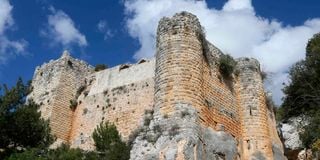
A view of towers of the outer wall of the Saladin Fortress, a UNESCO World Heritage site, in Syria's Latakia province on March 7, 2023. A devastating earthquake that hit Turkey damaged heritage sites including the Fortress of Saladin.
Zuhair Hassoun examines worrying cracks in a Crusader-era castle in Syria, a UNESCO World Heritage site that survived centuries of conflict only to be badly damaged by last month's deadly earthquake.
Hassoun, the custodian of the Fortress of Saladin, an architectural treasure with Byzantine roots in the 10th century rebuilt by Frankish Crusaders in the 12th century, walked carefully past fissured walls and crumbling arches.
"All of the fortress's towers are in danger," Hassoun said, warning that one had already fallen after the quake.
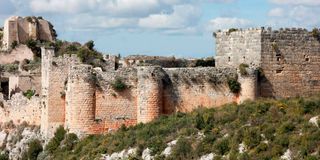
A section of the external wall and towers of the Saladin Fortress, a UNESCO World Heritage site, in Syria's Latakia province on March 7, 2023. A devastating earthquake that hit Turkey damaged heritage sites including the Fortress of Saladin.
Other parts "will inevitably collapse", he said, adding that it was only "a question of time".
The hilltop fortress surrounded by forest was among dozens of cultural heritage sites that officials say were damaged in the devastating 7.8-magnitude quake that hit Turkey and Syria on February 6.
More than 50,000 people were killed in the disaster, almost 6,000 of them in Syria.
Ancient sites damaged included the Syrian city of Aleppo's famed citadel and Old City.

A section of the Saladin Fortress, a UNESCO World Heritage site, in Syria's Latakia province on March 7, 2023. A devastating earthquake that hit Turkey damaged heritage sites including the Fortress of Saladin.
Dozens of sites damaged
The Fortress of Saladin has been on the United Nations' World Heritage List since 2006, and on the list of World Heritage in Danger since 2013, two years after the start of Syria's civil war.
But the castle, in western Syria's mostly government-held province of Latakia, scraped through the conflict unscathed and was still open to the public -- until last month's quake.
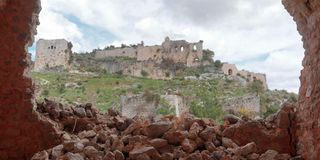
A section of the Saladin Fortress, a UNESCO World Heritage site, in Syria's Latakia province on March 7, 2023. A devastating earthquake that hit Turkey damaged heritage sites including the Fortress of Saladin.
Hassoun said he feared that aftershocks or even heavy rain could cause further damage to the site, whose main facade is now cracked from top to bottom.
"Every (stone) slab weighs at least a tonne," he said. "Any part of the fortress that falls into the valley can never be retrieved."
The earthquake hit one of the longest continuously inhabited areas on the planet within the so-called Fertile Crescent home to ancient civilisations including the Sumerians and Phoenicians.
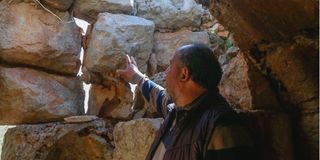
Custodian Zuhair Hassoun of the Saladin Fortress, a UNESCO World Heritage site in Syria's Latakia province, shows areas of damage on March 7, 2023, due to a destructive earthquake a month earlier.
This rich history has left behind a plethora of archaeological sites, many of them thousands of years old.
At the national museum in the capital Damascus, the head of the antiquities and museums department pored over a map of quake-stricken Syrian heritage locations, including in areas outside government control.
"We have identified more than 40 damaged sites," Nazir Awad said, noting that the provinces of Aleppo, Idlib, Latakia and Tartus were badly affected.
"The Citadel of Aleppo and the Old City recorded the worst damage," he added.
The day of the quake, AFP photographers saw damage in Aleppo to parts of the citadel, including to a minaret of a mosque at the World Heritage site.
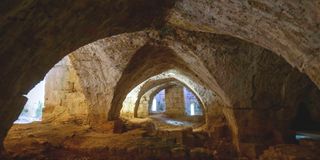
A hall with a vaulted ceiling in the Saladin Fortress, a UNESCO World Heritage site, in Syria's Latakia province on March 7, 2023. A devastating earthquake that hit Turkey damaged heritage sites including the Fortress of Saladin.
UNESCO, in a preliminary assessment, cited "significant damage" to the citadel and said the western tower of the old city wall had collapsed, while several buildings in the souks had been weakened.
'Urgent intervention'
Some Syrian heritage sites "require urgent intervention so we don't lose priceless historical treasures", Awad said.
He called for "international quake experts" to assess damage across the country, citing reports of "severe damage" to several sites in rebel-held areas.
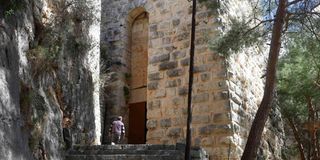
Custodian Zuhair Hassoun of the Saladin Fortresss, a UNESCO World Heritage site in Syria's Latakia province, leads the way into the citadel on March 7, 2023, to show damaged areas due to a destructive earthquake a month earlier.
An AFP photographer saw heavy damage to the Saint Simeon Stylites monastery -- am ancient Christian pilgrimage site named after a famous hermit -- in northern Aleppo province, an area controlled by the Hayat Tahrir al-Sham jihadist group.
In the north of neighbouring Idlib province, some of the walls and courtyard arches of a centuries-old castle in the border town of Harim had collapsed, another AFP correspondent said.
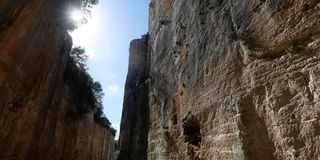
A rock-carved moat of the Saladin Fortress, a UNESCO World Heritage site, in Syria's Latakia province on March 7, 2023. A devastating earthquake that hit Turkey damaged heritage sites including the Fortress of Saladin.
Firas Mansour, a teacher and antiquities enthusiast in Harim, one of Syria's worst-affected areas where dozens of buildings crumpled as residents slept, said he was not surprised that modern buildings had been destroyed.
"But for a castle that withstood centuries of stress to collapse, it is shocking and sad," he said.





